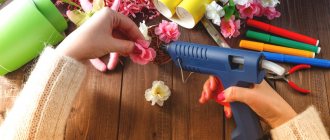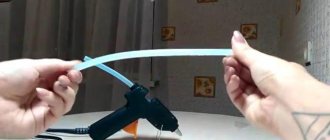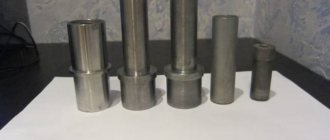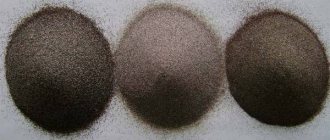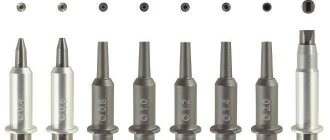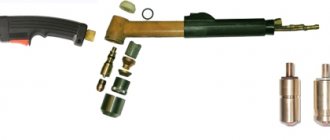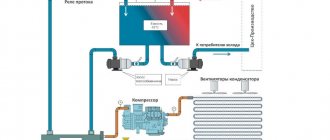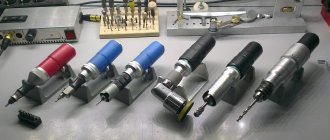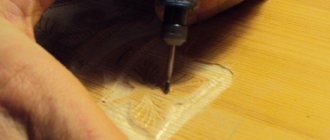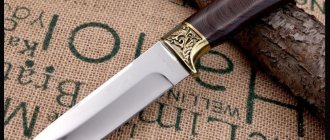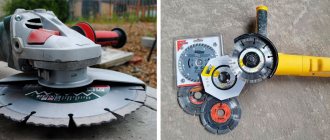Carefully! Electric current | 09/01/2016
Today, we will look at a tool capable of gluing together various materials; it is used in many sectors of the national economy. The hot glue gun has gained popularity among many craftsmen due to its fairly simple design, ease of use and low cost of consumables. With the help of such a tool it is convenient to solve not only practical problems, but also to use it in the field of interior design.
What is it and how does it work
A hot glue gun is one of the simplest electrical equipment. A plastic rod inserted into a special compartment is pressed through the heater assembly and nozzle. The output is a molten stream that quickly hardens in air. There are several modifications, depending on the size of the glue stick:
- 11 millimeters (household);
- 16 millimeters (industrial).
There are also 7 mm rods, but they are rare. The power of thermal guns varies widely - from 15 to 100 watts. The dimensions and functions change accordingly. But the main task remains: melting and pressing the glue.
Design
The body of the heat gun consists of 2 fastened halves with a hole for installing the rod (on the back), a nozzle and a start key rocker. Everything is simple, no frills. For ease of work, a folding spring stand is installed in front. Sometimes the pistol is equipped with a switch with a toggle switch. The device is simple and trouble-free. More complex models of heat guns are equipped with temperature control (positional, stepped, electronic). There are also battery models.
Principle of operation
The principle of operation of a glue gun is similar to an electric soldering iron. A heater combined with a nozzle gradually melts the plastic. The rod, inserted into a special gripper, gradually enters deeper and deeper into the heater assembly. Hot glue is squeezed out through the spout, a new portion is supplied by pressing the start key.
The disadvantage of the simplest designs is that the unit is constantly in operation. Plastic drips can clog the nozzle; it must be cleaned periodically.
Problems and their solutions
The most common problem when working with a heat gun is that the glue flows uncontrollably, without pressing the trigger. There may be several reasons:
- The temperature is too high for a particular rod. It is optimal when the heat gun has a heating regulator to set the required melting degrees. Otherwise you will have to replace the rods. In a good gun, the nozzle has a ball valve - the so-called drip protection;
- The rod is inserted too tightly. Sometimes it helps to move it back a little;
- rod diameter mismatch. Some models require decimal sizes. For example, Sigma - 11.2 mm. If you put an 11 mm rod into such a device, a pressure difference occurs inside the heater, and the glue flows back. Using rods of the correct diameter solves the issue;
- low quality pistol. You can insert a toothpick into the nozzle during a pause in work. Or accept it and try to finish the work as quickly as possible: the contents flow out very quickly.
If the glue stops coming out, the gun may be clogged. It is disassembled and cleaned. To avoid this, do not allow glue to stick around the nozzle.
You can get excellent results and joy from work only with a working hot glue gun
For battery-powered models, the glue sometimes becomes viscous and has difficulty passing through the nozzle. You need to reheat the device in the charging station.
In cheap models, when there is a break in use for several minutes, the pusher gets stuck in the soft rod and cannot move it. You need to turn off the gun and let it cool.
If the glue stretches like a thread and you can’t apply a dot, craftswomen advise keeping the rods in the refrigerator. Most likely they are of low quality.
How to change the color of the rod correctly
To prime the gun, the rod is simply inserted into a special hole at the back. After finishing work, you don’t have to remove it. Then the next time you turn on the device will be immediately ready for use.
Sometimes it is necessary to change the color of the coming out glue, for example, blue to transparent
If the gun has cooled down, turn it on for about 1 minute, then carefully unscrew the rod. Charge the new one, press the trigger to squeeze out the remnants of the old one until the desired color appears
The new rod, after insertion, by smoothly pressing the trigger, completely pushes out the remnants of the old one
Key properties when choosing
The pistol is selected depending on the goals and tasks that it has to perform. For crafts, the most simple, low-power one will do. For repairs, a more serious unit will be needed. The same applies to the diameter of the working rods. The most popular is 11 mm. Smaller ones are less common, larger ones are used in industrial products.
It wouldn’t hurt to have a switch and a stand to secure the gun “at idle.” It heats up quickly, so the toggle switch does more good than harm. When choosing, you should not buy the cheapest, unsightly, poorly packaged pistols: they will not last long. It is better to give preference to legally manufactured products, with product details and a guarantee in case of breakdown.
Check valve reliability
The presence of a special device - a check valve - allows you to extend the life of the gun and get rid of unpleasant glue drips. Its reliability directly depends on the class of equipment and quality of manufacture, as well as handling of the device.
The check valve is a special ball that blocks the flow of glue in the nozzle. To increase the service life of the unit and the gun as a whole, it is necessary to periodically clean the internal channels of the frozen adhesive mass.
Glue heating time
This indicator is not the same for different models. It is related to power, the presence of a heating regulator, and the type of glue stick. On average, this is a period of up to 5 minutes. Industrial models, with a powerful heater and the function of changing the temperature of the melt, are ready to supply liquid glue faster than their smaller brothers. But the difference in price between them is considerable, and this also affects the choice of a housewife or a crafts maker of “Kulibin”.
Availability of attachments and extensions
Additional devices or additional parts always have a beneficial effect on the operation of the unit, since they expand the arsenal of its skills. In the case of a pistol, these are replaceable nozzles with different outlet diameters and special extensions. The benefits of them are undeniable: penetration into hard-to-reach places, regulation of the portion of glue squeezed out at the touch of a button. Simple models are usually not equipped with such accessories, only expensive and professional ones.
Rods
They differ in diameter (7 or 8 millimeters, 11, 25, and so on), melting point, color. Saving on normal rods for the sake of low-quality and cheap ones threatens uneven melting, the appearance of stretching “snot” and a decrease in the strength of the seam. Colored glue sticks are needed to create applications, three-dimensional figures, and fix some interior details.
Standard rods for all occasions are milky in color. They are used by 90% of pistol owners. Before purchasing consumables, you need to know what standard size a particular piece of equipment works with. The rod is not a pencil; trimming it and somehow inserting an 11 mm into an 8 mm pistol will not work.
Chamber size and heating element power
The hot glue gun is designed in such a way that the size of the heater, the “firebox” for heating the rod and the power correspond to the dimensions and class of the device. Small, 15-watt pistols have enough chamber to work with a 7-8 mm rod. Solid models are designed for a larger size, which means they will heat up a piece of glue faster and prepare it for work. This is pure physics, which also applies to glue guns.
See also
Characteristics and types of cork glue, instructions for use
Wire length
It would seem that this parameter is insignificant in comparison with others. But it is inconvenient to work with a “short-wire” gun: you need to be directly close to the outlet. The issue is solved by connecting an extension cord, but why do this if you can purchase a gun with a longer power cord?
Availability of replaceable nozzles
Another bonus that will be appreciated by those who plan to use a glue gun a lot and often. The nozzle is clogged, there is no time or desire to clean it - a spare tire will help. It also happens that the nozzle is hopelessly damaged, clogged with glue, and the working unit is needed urgently - changing the nozzle will also help. The total service life of the gun depends specifically on the condition of this unit (not counting the heater).
Power regulator
The presence of a function for controlling the melting temperature of the rod will be appreciated by those who do not have it on their pistol. It will melt everything at the same rate, regardless of the type of plastic charged. And an advanced gun with speed control is convenient because it allows you to save energy and vary the modes in relation to the characteristics of the glue stick.
Nozzle type
Most guns are equipped with standard light alloy nozzles coated with silicone. Options with different spout lengths are available to ensure ease of use for superficial and deep application of glue. The working diameter of the rod corresponds to a certain passage value for the glue in the nozzle, as well as the dimensions and standard thread size for mounting on the gun. It will not be possible to place a nozzle from a “small” unit on a “large” one. In the simplest models of pistols, the spouts are made non-removable and connected to the heating chamber.
What you need to know about glue sticks
What to make from hot melt adhesive is not the only question that needs to be sorted out; you need to understand that there are different stickers for a gun. They vary in diameter, shade and length. The diameter of the glue is important; it must be chosen strictly according to the permitted size for the device. The colors of the adhesives are as follows:
- Colorless, an option that matches any product;
- Multi-colored, the colors are matched to the color of the product so that the layer is invisible against the general background;
- Black ones are selected for sealing work;
- Yellow ones are suitable for paper, cardboard, finishing products;
- Shiny ones are used for crafts, white ones are suitable for seams between tiles.
The diameter of the glue is important; it must be chosen strictly according to the permitted size for the device.
Purpose
Glue guns are intended for decorative, installation, and professional work. There are even devices for straightening car body parts: using heavy-duty glue, they pull out dents in the sheet skin. There cannot be universal pistols. You need to immediately decide where the hot-melt adhesive unit will be used, and only then move on to the choice.
Decor
Gluing guns have long been used to create decorative panels and compositions to quickly and reliably attach parts to a base, surface made of wood or metal.
Repair
Another area in which glue guns have found application. To glue tiles to the floor, fix a suspended ceiling, or fix a wooden block to a stone wall, it is not necessary to use standard methods. 5 minutes of work with the gun - and the part is in place.
Needlework
A strip of glue from a gun glues fabric, thread products, knitting, and connects embroidered pictures to the base. The polymer mass replaces conventional synthetic adhesives, and surpasses them in strength and speed of hardening of the seam.
Construction
Fastening carpet, installing electrical fittings, securely fixing plumbing fixtures - and a glue gun will help with this. Polymer rods have high adhesion to any surface. You just need to clean them from dust, degrease and dry them.
Warehouses and movers
The device is suitable for temporary fastening of structures in a warehouse, creating an instant connection between plastic and metal, wood and glass. One powerful gun is enough to apply glue in a small warehouse. You can fix parts pointwise, in stripes, along a contour - there are enough options for a solution. It’s also convenient to use colored rods to mark goods, creating a strip of glue in the required place.
Life
Repair broken dishes, glue tiles, flooring, fix the tabletop. To do this, you do not need to keep several different synthetic adhesives on hand.
Having a compact, reliable gun with a set of rods immediately solves all the problems of a home craftsman.
Plastic and PVC models
And with the help of molten glue you can quickly and reliably fasten plastic parts together. But not all. There is a restriction on PVC; Hot glue cannot repair a torn shower curtain.
Fabrics
Such a complex and impractical material to glue as fabric, with rare exceptions, is successfully joined using a hot-melt gun. The choice of base and combination of fibers does not matter - for hot-melt adhesive they are all equivalent and are easily bonded.
Concrete, gypsum and similar materials
One of the few exceptions, white spots, for which a glue gun is not suitable. It will also not work to glue plaster or create a strong seam between the concrete surface and another structure (paper).
Decoration of interior items
Using hot glue you can make exclusive New Year's toys.
Christmas ball
To complete this craft you will need:
- Christmas tree decorations of different sizes;
- glue gun;
- paints of different colors.
Read also: Why are there a lot of cattle in Russia?
A pattern is applied in random order to the surface of the Christmas tree decoration using a glue gun. To add maximum originality, you can draw a flower, a bird or any other ornament on the toy. It will turn out very beautiful if you tint the toy. The base will be one color, and the convex pattern will be another.
Case for phone
Young fashionistas can decorate their phone.
You will need:
- glue gun;
- acrylic paint;
- rhinestones.
A random pattern is applied to the back panel with hot glue. You can give it a certain color using acrylic paint. This procedure must be carried out with a very thin brush.
While the glue is still wet, you can attach rhinestones for decoration.
When making this decoration, be careful not to allow a drop of hot glue to get on the camera or speaker.
A huge number of photographs of various decoration options can be found on the Internet.
What sticks
Thermoplastic rubber-like mass easily glues materials of different structure and origin. Paper, wood, cardboard, glass or rubber - all of them can be done with a glue gun.
Paper
Instant and effective gluing of paper using a quick-hardening compound is not a problem. Attaching a sticker, creating an airy openwork composition or a regular envelope with a heat gun in your hands is much easier than using other methods.
Cardboard
Cardboard, as a denser material, is more difficult to glue with conventional mixtures than paper. But using hot glue is easy. The seam is durable, waterproof, and can withstand loads. A significant advantage of the technology is that you do not have to wait for the solvent to evaporate (the glue dries). This significantly speeds up the assembly process.
Ceramics
Apply a layer of glue to one half of the broken cup, then to the other, wait 15 minutes. You can forget about this technique forever if you have a glue gun on your farm. Wait until it warms up, drop or strip hot melt glue onto the contact areas, press firmly - and the product is as good as new.
Tree
The high adhesion of the plastic mass allows you to easily connect wood together and attach bars to other materials. Before work, you need to make sure that the surface is cleaned of dirt and dust, dried, and degreased.
Styrofoam
Polystyrene foam is a hard-to-glue material and requires the use of special compounds. This does not apply to hot melt equipment. We load the rod into the gun, turn it on, and pull the trigger. Next we glue at least the ceiling tiles, even the baguettes. It sets instantly.
Glass
Another problematic substance for which it is difficult to create a strong seam. Connecting glass parts to each other, repairing a crack, or attaching a plate to another material without a glue gun is not only difficult, but sometimes impossible.
See also
Requirements for nail glue, review of the best manufacturers and how to use
Rubber
Quickly gluing rubber without using special technologies and without waiting several hours until the seam gains strength - this was impossible to think about before. Melted glue from an electric gun solves the problem in an instant.
Metal
Ferrous and non-ferrous metals have always been difficult to glue. For this purpose, synthetic mixtures and epoxy compounds are used, which have the greatest joint strength. But the gluing time is also considerable. Using a gun with a set of rods saves effort, time, and nerves.
How to choose a glue gun for crafts
If you often have to make something with your own hands or like to fantasize with crafts, you will need a compact and slightly powerful model of a glue gun. Pay attention to several main criteria:
- power . As you remember, the performance of the glue gun depends on this parameter. Of course, for creative use, a power rating of 15-100 W is sufficient, since more powerful ones will require appropriate operating skills;
- nozzle diameter. The smaller the hole for the adhesive mass to exit, the more accurately it will adhere to your invention. This option is ideal for handicrafts. Therefore, the optimal diameter of the heat gun nozzle is 2-3 mm;
- check valve Unfortunately, not all models have this equipment. This mechanism is necessary so that after the gun is turned off, the supply of molten glue stops automatically;
Apply a few drops of glue to baby booties and the floor will no longer be slippery
- additional nozzles . Such details are welcome for the implementation of a home hobby. Using an elongated needle, you can carefully glue beads or seed beads, but the volumetric attachment is useful for fixing larger parts;
- availability of stand . This part of the design is included not only for convenience, but also as the main element that prevents glue from spilling on the internal components of the glue gun;
- glue consumption . When choosing a gun for needlework, the glue consumption rate should be no more than 5-6 g/min. Thanks to this, you will not accidentally drip too much onto the craft, and the glue in the gun will melt more slowly.
Did you know that a drop of dried glue from a glue gun can perfectly replace a regular eraser?
IMPORTANT!
For needlework, you can buy glue sticks of different shades, with the addition of glitter, as well as universal cartridges. This is very convenient for those times when you need to make a colored model of a craft or a bright layout.
Main manufacturers
On the market of glue gun manufacturers, a unique rating of brands that you can trust has formed. Which one to give preference is the user's choice. Sometimes purchasing an unnamed model is justified if you need a tool for a certain period of time. If it breaks, you don’t mind throwing it away later. But among such “masterpieces” of Chinese consumer goods there is also a great marriage.
Dremel
A reputable North American brand, famous for its high-speed grinding machines, which came to be called Dremel. Thermal guns under this brand are reliable and fully worth the money spent on them. A switch is built into the handle, and a special stand is created in the front part. The nozzle is replaceable. It is convenient to work with such a gun, and it will last a long time. Dremel users, one and all, note the ergonomic handle of the unit and its lightness. But original glue sticks are not cheap.
Steinel
German scrupulousness, full compliance of the stated characteristics with the actual ones. Such a pistol, purchased for home crafts or repairs, will not let you down. Designed for a 220 V household network. There are models with temperature control, as well as battery-powered ones. By the way, autonomous Steinel pistols are considered one of the best: they contain electronic temperature controllers and an automatic shutdown unit.
Bosch
The products of the Bosch concern are known and respected far beyond the borders of Germany. Household and professional tools under this brand are reliable, trouble-free equipment. The products use high-quality components. Solutions are offered for amateurs and professionals. The pistol fits comfortably in the hand and is equipped with an electronic stabilizer.
The brand of the same name produces glue sticks of consistent quality. There are mains guns and compact battery guns.
Hobby and pro
Mid-class models for universal use are produced. The gun is equipped with a switch and has good ergonomics. One of the obvious advantages of the pistol is its low price (700 rubles). Provision is made for blocking the leakage of adhesive mass.
UHU
Another average one. You shouldn’t expect super quality from products under this brand, but the heat guns will live up to your hopes. They are classified as low-temperature (110 degrees), suitable for household purposes and handicrafts.
MasterHand
Cheap and cheerful - this is how the products of this manufacturer can be characterized. Not Bosch, but suitable for home crafts. There are no additional functions, including a power supply switch. There is no regulator either. One of the simplest and most inexpensive pistols, this is where its advantages end.
Stavr
Russian manufacturer. It produces pistols with good ergonomics, a replaceable nozzle and a convenient rocker key. Among the undoubted advantages is fast heating (about a minute). There is no control over the temperature regime for melting the glue.
Defort
Glue guns with conflicting reviews. Judging by the complete case and spare attachments (2 pieces), this is a tool for professionals. The slightly curved handle leaves a pleasant impression. But the price (up to 2 thousand) and the design of the suitcase are not particularly encouraging.
Kolner
A brand with mixed Russian-Chinese roots. The manufacturer provided a switch and lighting for the work area, and equipped the gun with a long power cable. And the price of the product is not too bad. In its price range, Kolner crushes its competitors with a set of additional functions; they almost never have a backlight or toggle switch. Not to mention the removable and spare nozzle.
Features of choosing a tool
A tool is usually purchased with the intention of using it for a long time, so it is important to choose an option that is convenient for you. The following parameters need to be taken into account:
- The presence of a battery will make it possible to work anywhere without being tied to the mains;
- Type of rod feeding mechanism, there is a slider and carousel version. The second one is less comfortable because you need to turn the handle and not press it, as in the first type;
- The number of heating elements, if there are several of them, then this is better. They will replace each other during operation, but the cost will also be higher.
The presence of a battery will make it possible to work anywhere without being tied to the mains.
What glue to use
For a good seam you need high-quality glue. On the other hand, there is no point in buying expensive Bosch or Dremel rods for a simple pistol. The choice of color depends on the nature of the work: colored glue is used for needlework and modeling. For repairs, the usual yellow one will do. Different rods do not have the same melting point, and this indicator is related to the characteristics of the gun. A “weak” unit will not cope with refractory glue. And, of course, the diameter of the rod must match the size of the grip in the pistol; this is an immutable axiom.
By color
The choice of color is important where it is involved in the composition; you cannot do without it. In other cases, “working” yellow glue sticks are used, which give a durable and neutral-in-shade seam.
Yellow transparent rods
It is a “universal soldier” for solving most problems. The yellow rod is most often used for working with paper, cardboard, and wood.
Multi-colored, opaque
This group of glue sticks, oddly enough, is also considered universal. This is explained by the fact that the shade is necessary to disguise the seam to match the color of the parts being joined.
Transparent adhesive
Transparent white rods are most in demand. They are included with glue guns and will be sold in hardware stores by default. The most common consumables.
Gray or black
Dark shades of glue sticks work to create a layer of insulation and are used as a sealant. In terms of quality characteristics, these glue sticks are not much different from others.
Opaque white
When a gun is needed to work with metal, glass, or joining white parts, you cannot do without glue sticks of the appropriate shade. Sometimes used as a marker.
By temperature
When choosing a glue stick by color, you should not miss another important characteristic - temperature. It is indicated on the packaging with glue sticks, as well as in the characteristics of the gun. It is measured in the range of 100-150 degrees, so using the glue “blindly”, which happens to be at hand, is fraught with unexpected consequences.
It is always better to check the type of glue stick and whether its melting point matches the capabilities of the gun.
Safety precautions when operating the device
When working, do not forget about safety, the device operates from the mains, and high temperatures are also used, so the operating standards are observed:
- Study the instructions for the device, which states how long the gun can be used without interruption;
- Do not turn on the device without hot glue;
- The cable must always be placed at the rear of the device;
- The tip of the nozzle and the adhesives themselves become very hot during operation; they should not be touched during this period;
- Working in wet conditions is prohibited; hands should not be wet either;
- During operation, the glue is placed on a stand; it is not installed horizontally, otherwise the melted glue will damage the equipment.
The tip of the nozzle and the adhesives themselves become very hot during operation; they should not be touched during this period.
Read the instructions
The most disliked condition by Russian users. As a result, the pistol that worked in the store at home for some reason refuses to cooperate, and the rods bought on the cheap do not want to melt normally, drip and shoot. Most problems with technology are hidden precisely in the lack of knowledge about the principles of its operation. If the instructions say that the glue gun should not be left on for more than half an hour, and then you should give it a rest, then that is exactly what you need to do.
See also
Types and scope of application of fish glues, how to make them yourself
Wardrobe fragrance
A pleasant smell in your wardrobe is important, because fabrics tend to absorb all odors. It is for this reason that housewives usually use sachets or other flavorings. And you can use your favorite perfume, and a glue gun will help with this again.
PHOTO: YouTube.com Draw an adhesive mesh on a polyethylene backing and wait until the composition hardens
PHOTO: YouTube.com Make two identical meshes, and prepare a hook on one of them using the same glue. Place a piece of fleece or felt between the meshes and connect them along the edge
PHOTO: YouTube.com All you have to do is hang the improvised sachet on a rod in the closet and sprinkle it with your perfume
Price categories
Prices for pistols, like any instrument, vary widely. There are simple ones, for 600 and even 400 rubles, and there are supermodels for 2.5 thousand. In the lower range there are unpretentious products with a minimal set of options. The exception is the Kolner with a long cable, a replaceable nozzle and a switch key on the handle.
The cheapest Dremel will cost 800 rubles, and it does not have any additional functions. Convenient, productive models of self-powered pistols (built-in lithium-ion battery) Bosch or Steinel cost 2400-2500 rubles. For comparison: a Bosch network high-temperature gun costs 2.1 thousand rubles.
Units costing more than 5 thousand are considered professional. If you need a pistol one-time, you can find a model for 300-400 rubles, a “one-day” one, since among similar products the mean time between failures is low. They are not even repaired, they are simply replaced with new ones.
Professional and household hot glue guns
The cost of a hot glue gun varies; all guns are basically similar in design, but professional models are more powerful and can be equipped with additional features. This is done due to the specific nature of the use of devices by professionals; in such cases, a large amount of work is implied, and it is necessary that the glue be heated for a long time without interruption.
For simple household use, this property is not necessary; when you glue a little, you can get by with an inexpensive gun.
A model with a power of 40-150 watts is suitable for everyday use. Professionals may require up to 500 watts of power.
A model with a power of 40-150 watts is suitable for everyday use.
If you haven't read the instructions
Basically, a glue gun is not a space shuttle or even a supercomputer. It is difficult to spoil it through unintentional actions. It is enough to act by trial and error, following the basic simple rules. And the process of mastering the glue craft begins with preparation.
Preparation
You bought (rented from friends) a glue gun. You don't know or have forgotten how to use it. First, remove the unit. To do this, the gun is removed from the blister (cheap and household models) or suitcase (professional). The set “gun + glue” should be formed. This involves installing the nozzle, selecting the rod and plugging it into the outlet. Autonomous models are charged until the battery is fully ready. For models with manual temperature control, the regulator is set to minimum. For those equipped with a toggle switch, you need to press the key, switching it to power supply mode. And only after this can we begin field testing.
Usage algorithm
The method of using a heat gun is simple to the point of primitiveness: wait for the set time for the rod to warm up, press the button, squeezing out a stream of glue, release, then press again. There is no need to press hard on the lever, trying to speed up the flow of not completely melted glue. Such impatience will result in the gun breaking.
By directing the nozzle and synchronously working with the rod pushing key, a layer of glue is formed on the part (the seam is filled). The length of the rod is not infinite, so at the same time they monitor the glue consumption, adding new cartridges in time. Sometimes the glue comes out with a characteristic pop, this is not a breakdown, just air. The rod should fit tightly into the grip, resting against the chamber. As it warms up, it is moved forward. Before changing the type of rod (by color, melting temperature), it is advisable to clean the nozzle.
To do this, the gun is allowed to cool, disassembled, and cleaned with a wire or pin. It is recommended to perform the same procedure when you stop working with the gun. The nozzle is the hottest part of the glue gun. On some models, the body becomes noticeably hot. On average, the temperature is 100-110 degrees, and the output is glue.
Careless handling will most likely result in burns. Therefore, compliance with personal safety requirements (gloves) is a necessary condition. The glue sets within a few seconds; some skill is required to operate the gun effectively.
Usage time
The average time to use a glue gun is 30-40 minutes, depending on the model and individual features of the unit. The body and handle of different products do not heat up equally, this also affects the duration of operation. Another limiting factor is the length of the glue stick. Usually, after the glue cartridge runs out, it is recommended to clean the nozzle before installing a new one. This will be the operating time of the gun. In advanced designs, the heater does not remain constantly on. When idle, it automatically switches to stand-by mode to save energy and extend the life of the gun.
How to use: charge, warm up, replace the rod
The small device is made using modern technology and is very easy to use. To avoid interruptions in work, the points for applying glue are planned in advance and all the necessary materials are prepared. The viscous mass cools quickly, especially in low-power models. The sooner you apply little things like beads, rhinestones or sequins, the stronger they hold on. The operating procedure is as follows:
- Connect the device to the network. If there is a power button, put it in operating mode.
- Insert the rod into the special rear hole until it stops. Leave to heat for the time specified in the instructions, ranging from 2-10 minutes. The plastic body of the heat gun also gets hot. By touching it, you can check the operating status of the device if there is no power indicator.
- Press the feed control button. A drop of hot substance will appear - the device is ready for use.
- Apply glue to one of the parts and immediately press the surfaces to be glued together. Can be applied spotwise or in a stream. The glue releases as long as the trigger is pulled.
- If any remaining glue appears, remove it with a sharp knife after cooling. The hardening area can withstand mechanical loads after 5 minutes.
During a break in work, the gun is placed on a stand. The nozzle should point downwards; it is advisable to place some kind of substrate under it. Silicone is better because the glue does not stick to it. Then no hot residue will get onto the work surface.
A special stand for the heat gun protects the working surface from hot drops and fixes the device
In the window of the gun you can see when the rod ends. To continue work, insert the next one, which will push through the remains of the old one.
Bonding points can be separated by heating.
Advantages and disadvantages
A glue gun is an easy-to-use item. With its help, it is easy to connect the parts in a craft, seal the seam, and glue the floor covering. But there are no truly universal models that can be used in any situation.
Pistols differ in rod diameter, set of functions, and sizes. It is impossible to get a complete set for a minimum price, and an expensive, fully equipped unit is not always needed on the farm. And it doesn’t make sense to buy a pistol for 2.5-5 thousand if you can get by with a cheaper analogue.
Another weak point is the need to select rods for a specific type of work, gun parameters, mode, and this is not always convenient.
How to make a snowflake
This type of craft with a glue gun for beginners will be as simple as possible to create; once you get your hands full, you can move on to more complex elements.
Read also: Child manipulates parents
To implement the plan, the child will need the following set of components:
- Dry gloss, you can choose the color yourself.
- Nail polish.
- Wax paper can be replaced with regular cellophane.
Important points when using
The glue stick must be inserted into the gun carefully, ensuring that it is grasped with an elastic band. A nozzle passage clogged with frozen glue is the cause of failures and breakdowns of guns. Therefore, you should develop the habit of cleaning the nozzles after finishing work. When the gun is not in use, it must be turned off. In models with a toggle switch, this action is performed by pressing a key; in conventional models, the plug is removed from the socket. The position of the pistol in the idle position is with the nose down, on a special stand and nothing else.
Original decorations using glue
Making crafts using a glue gun is not difficult for beginners; for this you need to choose an idea and additional tools. Hot-melt glue sticks are suitable for independent use as a material for crafts, and shiny and colored glue will be a wonderful decoration.
Volumetric decor for wall decoration
Three-dimensional decor, which can be created with glue, will help decorate any horizontal and vertical surfaces. The surfaces on which hot glue will be applied must be pre-treated; for drawing and creating three-dimensional installations, it is better to use colored rods.
Trifle stands and candy bowls
To create this craft, you will need a container made of dense material, which will serve as the basis for the craft. It must be turned over and the outer edge covered with cellophane, and then with a layer of thick glue, after which glue can be applied to this surface, forming a frame with holes.
Cross decor can be replaced with monograms and spiral decorations, and large drops of glue can be connected together. After the craft has dried, you can remove it from the stand and use it for bread or fruit, or put away useful little things such as keys or writing utensils, glasses.
Candlesticks made from glue sticks
Long glue sticks are used to create crafts; they can be used to assemble beautiful products for various purposes. The sticks can be cut using a sharp stationery knife, and then place a glass glass in the center and paste it with the resulting elements.
Ready-made candlesticks are suitable for use outdoors or indoors, and if you place the sticks at intervals you will get good lighting. In the same style, you can create street lamps by decorating tin cans left over from food products with colored rods.
Characteristics of hot-melt adhesive rods
As already mentioned, the release form in the form of hot-melt adhesive rods is the most common due, first of all, to ease of use in conjunction with hot-melt guns of both professional and household class.
There are rods on the market with various properties and characteristics, which are usually indicated on the packaging.
Purpose
Hot-melt adhesive in rods differs primarily in color, which usually indicates its purpose.
However, it should be noted in advance that although there is a clear unification here, not every manufacturer adheres to it, which should be kept in mind when choosing these consumables.
Usually available to the buyer:
- White translucent rods are universal, used both in industry and for domestic needs.
- Opaque colored rods are similar to the previous option, but the only difference is that their color performs a camouflage or decorative function. They are mainly used for gluing colored objects.
- Opaque white rods - have different purposes, depending on the manufacturer and composition. Some can only glue glass, while others are a universal option for connecting white objects (similar to the previous point).
- Transparent yellow rods - have a universal composition, which is mainly intended for gluing wooden, cardboard and paper products. There are opaque yellow sticks, with which they should not be confused, again, by analogy with the second point.
- Gray or black rods are elastic sealants designed to insulate electrical conductors and seal seams, therefore they are not directly related to hot-melt adhesives as such.
Material
Hot-melt adhesive rods are most often produced on the basis of ethylene vinyl acetate, due to which they have a low melting point, which was already noted earlier, and therefore, it is possible to use them in conjunction with.
There is also a relatively low cost.
The base can also be polyamide or modified silicone.
The latter is well suited for working with fabrics.
Dimensions and weight of hot melt glue sticks
The diameter of the produced glue sticks can be 7 – 12 mm.
The most popular sticks are 7 and 11 mm. The length of such glue sticks reaches 100 – 300 mm.
A package of 6 – 10 rods weighs about 50 – 150 g.
Choosing a heat gun for home needs
Obviously, for occasional home use it is better to buy a household model, but to do a lot of work you need a reliable professional tool. What is the difference between them?
Hobby glue guns are so inexpensive that they fall into the category of “must have” tools for DIYers. Their low cost does not mean at all that they are inferior in performing everyday tasks in comparison with expensive tools.
First of all, devices for amateur purposes are lightweight and compact, which makes them convenient for an inexperienced user. Household devices do not need a high speed of supply of hot glue - there is unlikely to be a need to quickly glue large surfaces. And an unskilled user will not be able to apply a large amount of glue without drips and accurately. Therefore, amateur devices do not necessarily have to be powerful. It is more important that they do not burden the hand and are easy to maneuver.
Since they are supposed to work at home with easy access to the power supply, the devices are equipped with only a cord and plug for power supply. Additionally, the tool can be equipped with a function for unfastening the power cord. In this case, after turning off, due to the inertia of cooling, the gun continues to glue for 10-15 minutes, which is quite enough for most household work.
Another difference with professional ones is the size of the cartridges for which the tool is designed. It is unlikely that large diameter rods will be needed in everyday life. Only if it is necessary to create something huge may there be a need to increase the sections to the maximum. For normal work, the optimal size would be 7 mm.
The ability to change the nozzle can be useful for solving artistic problems. Experienced designers know how expressive raised patterns can be when using glossy rods.
For large volumes of work
As a rule, amateur devices are powered from the electrical network. More serious tools require operation in conditions that do not allow for connection to a power source using a cable. For example, these could be some repair and construction tasks. For such cases, there are battery-powered models. Their continuous operation time depends on the battery capacity, the possibility of their replacement and their own power. The disadvantage of such heat guns is the need to take care of charging the battery.
In addition, professionals often deal with large surfaces for gluing, considerable volumes of work, harsh operating conditions for tools, as well as adhesive mixtures that require elevated heating temperatures. Therefore, heat guns for non-domestic needs, usually of high power, are equipped with more reliable and complex mechanisms, are made in a durable body and have the ability to use long and thick rods in order to ensure high glue consumption. All this, together with the autonomy of the power supply, makes them much heavier and more expensive than amateur instruments.
Sometimes gluing technologies require the use of special two-component compositions. There are machines on sale for working with mixtures. The principle of their operation is the same as that of standard models. The only difference is that the materials to be joined are fed into the heat chamber separately, evenly and in compliance with proportions.
All of the above must be taken into account when choosing a professional instrument - unlike an amateur one, due to greater specialization it is less universal.
Creating Individual Elements
Using hot glue, you can independently create a wide variety of figures: these can be crafts in the form of animals, various flowers and plants, birds, snowflakes, etc.
Snowflake
For joint creative activities with your child, you can start with something very light, for example, a snowflake.
To make it you will need:
- dry shine of any color;
- acrylic paints or nail polish;
- glue gun;
- wax paper or any cellophane.
To facilitate the process, a silhouette of the future snowflake is drawn on paper. Next, glue is carefully applied to the drawing. Be careful not to go beyond the outline of the drawing. After the glue has completely dried, after 2-3 minutes, we begin the process of decorating the snowflake. This can be done using regular glitter, acrylic paints or even nail polish. It all depends on the materials available, and of course your imagination.
figurine
To create a figurine you need to prepare:
- glue gun;
- acrylic paint or nail polish;
- additional elements for forming a muzzle (button - nose, heart - decoration);
- magnet;
- Keychain mount.
The outline of the future figure is applied to wax paper or a bag. Next, using hot glue, all voids are filled and contours are formed. With the help of additional elements, you add “liveness” and individuality to your craft. If you plan to make a magnet, then before the part has cooled down, you need to attach a magnet to the back of it. The nose can be made from a small button or formed from the same hot glue.
Using the same principle, you can make an unusual individual badge by simply attaching a pin to the back of the figure.
Range
Hotmelt adhesives of various colors are in demand, as this makes it possible to choose the adhesive to match the color of your material so that the adhesives do not stand out. Of course, PVA cannot be compared with thermoplastic glue; PVA does not have such strong adhesion.
The most common shades available on the market are transparent (universal: suitable for cardboard, ceramics, plastic, fabric, tiles), opaque (for glass and metal), yellow (suitable for wood), black (suitable for insulating wires, suitable for as a sealant), colored (suitable for decorative work, used on cardboard and paper).
Popular models:
- Bamfutura;
- 5 second fix;
- Rtv-904;
- Sealant;
- Termo.
They differ in technical properties: fire resistance, electrical conductivity, thermal conductivity, heat resistance.
